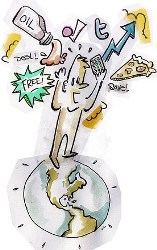 Influence of mobile phones in our lives has grown significantly over time. From a simple talk technology, now it is used to send SMS, MMS, browse internet, watch T.V., and make payments. With the advent of 3G services, the potential of mobile as a customer engagement medium will grow significantly. Marketers and advertisers will leverage the direct and instant reach of mobile to reach out to their customers.
Influence of mobile phones in our lives has grown significantly over time. From a simple talk technology, now it is used to send SMS, MMS, browse internet, watch T.V., and make payments. With the advent of 3G services, the potential of mobile as a customer engagement medium will grow significantly. Marketers and advertisers will leverage the direct and instant reach of mobile to reach out to their customers.
Mobile marketing (M-marketing) involves launching marketing campaigns via mobile. With 3G picking up and WiMax/LTE (4G) on its way, it’s the right time to analyze opportunities and challenges that are in store for mobile marketing industry in India.
Let us quickly analyse why Indian telecom market is capturing the attention of global mobile marketing companies and leading brands. If we go by TRAI figures, we are serving the second largest telecom market in the world, which accounts to 621 million telephone subscribers as of March 2010. Almost more than 90{af589cdba9d77786c8c861317dbad60bba1e2ebbf56e2ffab874a1b59fde9ce3} of them are currently using 2G/2.5G/2.75G for wireless access.
According to Frost & Sullivan, 3G would iron out quite a few things for operators, particularly in metros like Delhi & Mumbai. The report states that 20{af589cdba9d77786c8c861317dbad60bba1e2ebbf56e2ffab874a1b59fde9ce3} of the metro subscribers would migrate to 3G in the first year of launch, which accounts to 18 million or 3{af589cdba9d77786c8c861317dbad60bba1e2ebbf56e2ffab874a1b59fde9ce3} of total mobile sub base.
We call these 3{af589cdba9d77786c8c861317dbad60bba1e2ebbf56e2ffab874a1b59fde9ce3} sub base as early adopters, which also forms the target base for all mobile marketers, looking forward to leveraging the promise of NGN (Next Generation Network) for generating revenue.. The report also predicts that early adopters would spend approx 15{af589cdba9d77786c8c861317dbad60bba1e2ebbf56e2ffab874a1b59fde9ce3} of their mobile expenditure on Mobile VAS, which currently stands stagnant at 10{af589cdba9d77786c8c861317dbad60bba1e2ebbf56e2ffab874a1b59fde9ce3}.
In retrospection, every technology has significantly contributed to marketing techniques or channels. Starting from 1G (Voice Communication), where mobile telemarketing was the trend of time to current 2G (Data Communication), where marketing campaigns relied heavily on mobile SMS/MMS to spread the word, each mobile technology generation has inspired innovative marketing tools and techniques.
What hasn’t changed over the generations are the three prime characteristics of mobile as a marketing channel – capabilities to launch location specific, personalized and interactive marketing programmes. Definitely, NGN (3G/4G) & allied VAS would impart momentum to mobile marketing by enabling operator’s better exploit these features.
3G or Internet communication would extensively use Mobile Web/Internet as primary tool to target subscribers. But we also have to keep in mind India is still unprepared to promote Mobile Web as tool for marketing. Latest TRAI report states that there are only 16 million Internet subscribers in India, while broadband sub base has yet to cross 10 million mark. It means less than 1{af589cdba9d77786c8c861317dbad60bba1e2ebbf56e2ffab874a1b59fde9ce3} of total mobile subscriber can access Internet. It is also noteworthy that (according to IMRB International), out of 18 million Internet sub base, 58{af589cdba9d77786c8c861317dbad60bba1e2ebbf56e2ffab874a1b59fde9ce3} still rely on Cyber cafes, while only 4{af589cdba9d77786c8c861317dbad60bba1e2ebbf56e2ffab874a1b59fde9ce3} have accessed the Internet via mobile. This means that only around 1 million subscribers in India access via mobile phones. In summary, the democratization of 3G and mobile marketing adoption will not happen immediately.
But it will be worth starting off with early adopters of 3G. They will have a high propensity to adapt innovative services and will be friendlier to new technologies.
Meanwhile, we should by no means sideline the potential of 2G subscriber base which will continue to outnumber 3G subscribers at least for a few more years to come. According to Wireless Intelligence, in Asia Pacific region, GSM (2G) would continue to hold bastion even beyond Q2 2014. As per one estimate approx 68{af589cdba9d77786c8c861317dbad60bba1e2ebbf56e2ffab874a1b59fde9ce3} of subscribers in APAC region will continue to use 2G services (beyond 2014), while 13{af589cdba9d77786c8c861317dbad60bba1e2ebbf56e2ffab874a1b59fde9ce3} of them would switch to WCDMA/HSPA. This presents an exciting and challenging situation for mobile marketers. 2G/3G/4G will co-exist in India for many more years to come. The test for marketers will be maintaining the right balance by integrating diversified channels including SMS, MMS, Mobile Web, Internet Marketing and mobile T.V.
Whatever the channel mobile marketers may use to engage the customers, two fundamental principles will remain key for the success of mobile marketing – relevance (of the channel/ offer/ time/ context) and real-time response to customer needs. The ability to roll out relevant and real-time mobile marketing campaigns to a large extent depends on the ability to leverage real-time subscriber data.
Mobile is a real-time medium; it will be a serious error to compare it with any other digital or online marketing channels. Therefore, the technologies used for offline marketing channels and even web based channels will not be effective for mobile.
“Mobile is real-time medium and before emerging as stand alone revenue generating medium, it would continue to complement existing traditional marketing mediums such as print & broadcast in India for quite some time”
The deployment of right technology will be the critical first step for the launch of successful mobile marketing strategies. Otherwise, mobile operators and marketers will always face the risk of losing customer trust, and the value of mobile as a marketing channel itself will be at stake.
For operators and advertisers, it is the beginning of a promising journey. It would be interesting to watch how various stake holders in the mobile marketing value chain make use of the opportunity.



